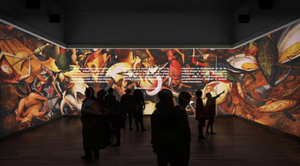
The Royal Museums of Fine Arts of Belgium and the Google Cultural Institute are launching the Bruegel / Unseen Masterpieces / project, for the first time ever, bringing together eight prestigious international museums around the figure of Bruegel the Elder. Drawing on a wide spectrum of virtual and onsite experiences, this unique initiative offers everyone the chance to immerse themselves in Bruegel's masterpieces.
On 15 March 2016, the Royal Museums of Fine Arts of Belgium and the Google Cultural Institute are launching the Bruegel / Unseen Masterpieces / project, for the first time ever, bringing together eight prestigious international museums around the figure of Bruegel the Elder. Drawing on a wide spectrum of virtual and onsite experiences, this unique initiative offers everyone the chance to immerse themselves in Bruegel's masterpieces. The artworks - many of which haven’t been moved for over 100 years due to their fragility - are now brought together with the help of cutting-edge technology. Amongst the works are 12 paintings, representing a quarter of Bruegel’s painted work, which are now online in ultra-high resolution, using a technology as ‘gigapixel’. The Google Cultural Institute is fast becoming the reference platform for Bruegel’s works, with 45 paintings, drawings, prints and a woodblock accessible online.
“Unseen masterpieces”?
Using ultra-high resolution gigapixel imagery, Bruegel / Unseen Masterpieces / allows people to delve into the depths of Pieter Bruegel the Elder’s († Brussels, 1569) works. The viewer will discover the unexpected details in Bruegel's paintings which constitute the pinnacle of the Flemish master’s craft. While the artist and his art are known worldwide, every composition also depicts a whole host of characters – some surprising, others familiar – and vignettes that provide the subtext of history: these are masterpieces worthy of exploration in their own right.
A unique experience at the crossroads of art and technology
As part of the Bruegel / Unseen Masterpieces / project, 12 of Bruegel's masterpieces from some of the most prestigious museums in the world are presented in detail invisible to the naked eye, thanks to technology provided by the Google Cultural Institute. The resulting images, together with iconographic resources and expert knowledge from each museum, have produced innovative experiences which let the public view a vast array of details and stories: 
- 19 virtual exhibitions exploring the painter's masterpieces and documenting his life, influences and legacy are now available to all on the Google Cultural Institute website. At the Royal Museums of Fine Arts of Belgium, 12 of these multimedia exhibitions are presented on interactive terminals developed specially for this project.
- The Royal Museums of Fine Arts of Belgium have also developed the unique apparatus of the Bruegel In one of the museum's rooms, immersive videos - each dedicated to a painting - are projected on three walls, floor to ceiling, thanks to a sophisticated system of projectors and ultra-high resolution images provided by the Google Cultural Institute. Spectators will get shoulder-to-shoulder with the villagers of Bruegel’s Proverbs (1559), face to face with the palm reader of the Sermon of Saint John the Baptist (1566) or have The Fall of the Rebel Angels (1562) at their fingertips. Box, created with the support of global energy player Engie.
- The Google Cardboard virtual reality viewer provides another cutting-edge experience centred around The Fall of the Rebel Angels, using a smartphone to plunge the viewer into a 360 degree universe. This virtual reality experience is available on the YouTube channel of the Royal Museums of Fine Arts of Belgium. The painting comes to life in front of your eyes: you too become one of Bruegel’s creatures.
Bringing together artworks from 8 museums and 7 countries
The Bruegel / Unseen Masterpieces / project uses advanced technology to bring together many of the Flemish master’s best-known works, making much of Bruegel’s collection accessible to all. With the support of the Google Cultural Institute, a quarter of Bruegel the Elder's paintings (out of some 40 currently known works by the painter) can now be admired in ultra-high definition. Eight prestigious museums, many of them from Europe, contributed to this first phase of the initiative: ● Royal Museums of Fine Arts of Belgium, Brussels ● The Frick Collection, New York ● Gemäldegalerie, Staatliche Museen zu Berlin, Berlin ● The Metropolitan Museum of Art, New York ● Museum Boijmans van Beuningen, Rotterdam ● Museum of Fine Arts, Budapest ● Royal Collection Trust, London ● Statens Museum for Kunst, Copenhagen
"Thanks to technology, a new dialogue is opening up between visitors and paintings in the museum. Through the interplay of screens and paintings, everyone can now virtually step into the artworks to gain knowledge and learn new stories. The encounter between art and technology makes it possible to reveal secrets as yet unknown to the general public." “Most of Bruegel’s paintings are wooden panels which are very fragile and therefore difficult to move. Thanks to the idea of using new technology, future generations will be able to see these works that have survived history. In detail, in every imaginable way, freely, how, when and where they want.” Michel Draguet (General Director of the Royal Museums of Fine Arts of Belgium)

ArtDependence Magazine is an international magazine covering all spheres of contemporary art, as well as modern and classical art.
ArtDependence features the latest art news, highlighting interviews with today’s most influential artists, galleries, curators, collectors, fair directors and individuals at the axis of the arts.
The magazine also covers series of articles and reviews on critical art events, new publications and other foremost happenings in the art world.
If you would like to submit events or editorial content to ArtDependence Magazine, please feel free to reach the magazine via the contact page.